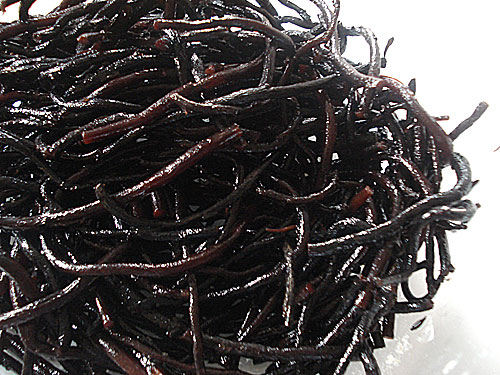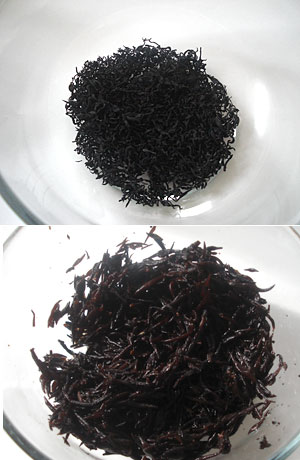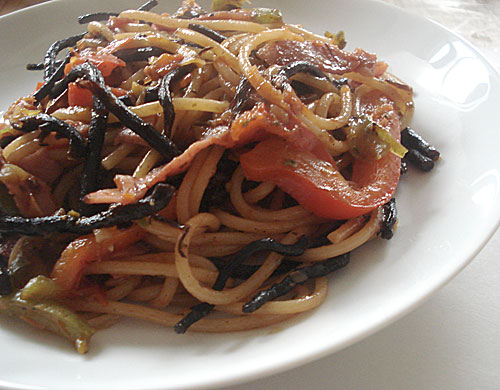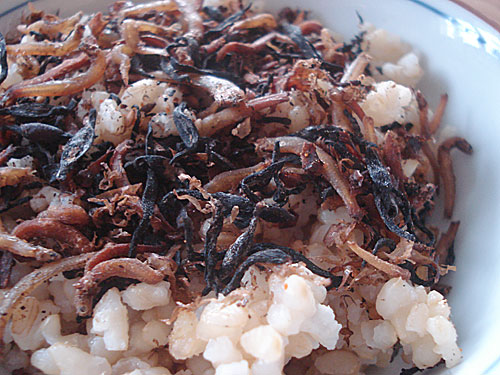Seaweed: Hijiki, wakame, kombu, nori, kanten

Next up in the OJFTMHYLW list is seaweed. But..why not call it sea vegetables? Weed sounds so unappetizing, so unwanted. Yet, seaweed is a terrific food.
There are many kinds of seaweed commonly consumed in Japan, and all are quite low in calories, contain many minerals, and are high in fiber. The only problem for a lot of people is that seaweed has a distinctive texture and flavor.
Wakame
Wakame, which often appears in salads, as garnish for sashimi, and in miso soup, has a rather slimy texture which just gets more slimy the longer it's soaked. If you can get used to this all the better of course. But if not, there are ways to get around this. First, try chopping it up very finely and sneaking it into food. Second, if you put it into soup (like for miso soup) the sliminess, which is actually a form of fiber, will melt into the liquid and be less noticeable. Also, sautéing in oil, or mixing with an acid like vinegar, counteracts the sliminess.
Kombu or Konbu
Kombu seaweed is most commonly used to make dashi stock, but it can also be eaten. The best way to eat kombu is to chop it up very finely unless you develop a liking for the leathery texture. You can also find kombu-cha, kombu tea, which is dried, salted and flavored pieces of kombu steeped in water.
Nori
Nori may be the most familiar seaweed since it's used as a wrapper for sushi. It's usually not cooked, though there are traditional recipes calling for softened nori. (Some people like a sort of soft nori paste to eat with rice...it is sort of like a Japanese version of Marmite.)
Kanten
Kanten, or agar-agar, is a coagulant extracted from a seaweed called amakusa. It's used like gelatin, but it has slightly different coagulation properties, and is all-vegetable of course.
Hijiki
Then there is hijiki, which may be the most versatile seaweed of all. It's also extremely high in fiber - about 40% of it in dried form is fiber. Hijiki is not commonly seen on the menus of Japanese restaurants since it's used mostly for homely home cooking. It comes in dried form, as do most other seaweeds (except for salted 'fresh' wakame). It's usually soaked for about an hour beforehand, then rinsed, before use, If you're in a hurry though you can blanch it for a couple of minutes in boiling water, which hydrates it quite fast. Hijiki when reconstituted swells to about 5 times its original weight, so don't use too much! A serving is usually 1 or two tablespoons worth at most.
 Hijiki comes in two forms mostly: regular hijiki, which is rather twig-like in dried form, and me hijiki, small buds of hijiki that looks like black tea in dried form. Once regular hijiki is reconstituted, it looks like long black noodles. Star Trek fans may see a remarkable similarity to gagh. However hijiki does not move on your plate or have feet.
Hijiki comes in two forms mostly: regular hijiki, which is rather twig-like in dried form, and me hijiki, small buds of hijiki that looks like black tea in dried form. Once regular hijiki is reconstituted, it looks like long black noodles. Star Trek fans may see a remarkable similarity to gagh. However hijiki does not move on your plate or have feet.
The traditional way to cook hijiki is to stew it in dashi stock flavored with soy sauce and often sugar, together with vegetables like carrot or lotus root, or fried tofu (aburaage). Since it's fairly neutral in flavor, it can be used in salads, or stir fries and such.
Hijiki safety concerns
There is just one caveat about hijiki. Four countries have issued warnings, but no outright bans, for hijiki, citing its more than accepted levels of inorganic arsenic. It should be noted that the initial tests on hijiki which lead to those warnings in the UK among other places was based on testing the dried, un-soaked hijiki - and you never eat hijiki that way. Soaking reduces the amount of trace arsenic by 1/7th; rinsing and cooking it in liquid further reduces it. The report here (Japanese) by the Tokyo Health and Welfare Department states that as long as a person weighing 50kg (about 110lb) does not eat more than 5 servings of hijiki of 5g dry weight per serving (which swells up to a lot more than that when soaked) that it is perfectly safe, even for pregnant women.
In a nutshell, when it's prepared properly (soaked, rinsed then stewed, and eaten with vegetables) I don't believe there is much to worry about. To me the many benefits of hijiki and other seaweed far outweigh the drawbacks. If I were the UK government, I'd be issuing dire health warning about things like blood pudding, but that wouldn't be politically popular! Some weird foreign seaweed is a much easier target. (And I do like blood pudding, once in a great while.)
In any case you should not consume large quantities of this or any other food (it's actually very hard, if not impossible, to eat a huge amount of hijiki) and it's often recommended to eat it with vegetables which may help to eliminate the inorganic arsenic from the body efficiently. Pre-soaking it and rinsing it before eating, which is the traditional way to prepare it, eliminates much of the arsenic content also.
Recipe: Hijiki and vegetable "Napolitan"

This is a non-traditional way of cooking hijiki, though note that the hijiki is still soaked, rinsed and stewed and eaten with vegetables. It adds fiber, flavor and interesting color to a pasta dish that's inspired by "Spaghetti Napolitan", a common item served in Japanese family-style restaurants and such, that has nothing at all as far as I can tell with Naples. It has tons of vegetables and a little bit of ham, which can be left out to make this a vegetarian/vegan dish.
This yields 4 generous and very filling servings.
- 100g / 3.5 oz dried whole wheat or regular spaghetti
- A small handful (about 5g) regular hijiki
- 1 red pepper
- 1 green or yellow pepper
- 1 carrot
- 1 small onion
- 1 clove garlic
- 120g / 4 oz proscuitto crudo (raw ham like proscuitto di parma)
- 1 400g / 1lb (small) can of crushed tomatoes
- 2 Tbs. tomato paste
- 1 Tbs. Worcestershire sauce
- 1 Tbs. olive oil
- Salt and pepper
Soak the hijiki, drain and rinse following the directions above.
Heat up a pot of water to boil the pasta.
Slice the vegetables thinly. Chop the garlic finely. Cut the ham into strips.
While you boil the pasta, heat up a sauté pan or wok. Put in the can of tomatoes and the vegetables. Simmer until the vegetables are soft and the moisture is almost gone. Add the oil and ham and hijiki and sauté briefly. Add the tomato paste and Worcestershire sauce. Season if needed with salt and pepper.
Drain the pasta and add to the pan, stir around to coat the strands well. Serve immediately, optionally topped with some freshly grated Parmesan cheese.
Recipe: Seaweed and chirimenjako furikake

Don't just settle for commercial furikake that's often loaded with MSG and other dubious ingredients. Furikake is quite easy to make at home, with only the things you want in it.
This furikake, which is just bursting with umami, can be made with any seaweed you like, or a mixture. Be sure to chop up the seaweed finely. This is most easily accomplished in a food processor, but you can chop by hand too. This one has a mixture of me-hikiji and nori. Chirimenjako is small, salted whole fish - you can find this or something similar in most Japanese, Korean or Chinese groceries. You can leave it out if tiny whole fish bother you.
- About 3-4 Tbs. of reconstituted, rinsed and drained me-hijiki, wakame, kombu etc.
- 2 sheets of dried nori, well shredded
- 3 Tbs. of chirimenjako
- A large handful of bonito flakes
- 3 Tbs. soy sauce
- 1 Tbs. sesame seeds
- Red pepper flakes, or seven ingredient pepper powder ( shichimi or nanami tohgarashi
- Optional: 1 Tbs. very finely chopped orange or yuzu zest
Chop the seaweed up finely. (If using me-hijiki you don't need to do much chopping.)
Put the moist seaweed and the chirimenjako in a non-stick frying pan over medium heat. Stir around until it's dried out quite a bit and is getting a bit crispy but not burnt. Add the soy sauce, the bonito flakes, and the shredded nori, and continue stirring until it's almost dry. Add the sesame seeds, citrus rind and red pepper, and stir until the sesame seeds are popping. Take off the heat. Store in an airtight container in the refrigerator, and try to use it up within a week.
Links
I find the information about seaweed in English to be rather spotty, so I've drawn most of my information from Japanese sites.
- Nutritional information on various kinds of seaweed (Japanese)
- The British find inorganic arsenic in hijiki! on About.co.jp (Japanese). Notes that soaking hijiki lessened the amount of arsenic to 1/7th, according to the British study.
- A statement on hijiki (English, PDF), from a U.K. natural food seller.
- Traditional hijiko no nimono (stewed hijiki) recipe on About.com (English)
If you enjoyed this article, please consider becoming my patron via Patreon. ^_^

 Welcome to Just Hungry, where we serve authentic Japanese recipes and more! I'm
Welcome to Just Hungry, where we serve authentic Japanese recipes and more! I'm 














Comments
Lizz
18 January, 2007 - 02:53
Permalink
Seaweed: Hijiki, wakame, kombu, nori... (OJFTMHYLW no. 2)
I finally found Sushi rice at a regular store. Well I think. It says Sushi Rice on it but it also says Medium Grain. All we really have is medium or long grain rice. Ah well. =D
Molly
23 January, 2007 - 11:10
Permalink
Seaweed: Hijiki, wakame, kombu, nori... (OJFTMHYLW no. 2)
I was wondering if you've ever heard of a sea veggie called haynari or enari sp?...I've been told to look for it by my naturopath. I can't find any matches when I google it. thanks...
anon.
10 October, 2007 - 22:03
Permalink
It’s spelled Inari. That
It's spelled Inari. That should help.
maki
24 January, 2007 - 11:08
Permalink
Seaweed: Hijiki, wakame, kombu, nori... (OJFTMHYLW no. 2)
I really don't know what those are Molly...maybe the spelling is wrong or different from what I know.
Anna
24 June, 2007 - 22:56
Permalink
Thank you, Maki, for
Thank you, Maki, for demystifying seaweed! I am playing around with seaweed recipes in an attempt to work on some thyroid issues, and have been scared to work with the stuff simply because I don't know what on earth to do with it (despite 3 years in Japan!)
consuelo
24 March, 2008 - 09:58
Permalink
japanese food
I lived in Japan for a while and my boyfried is Japanese(I am Italian.
Japanese food is really tasty, even for someone who is used to an Italian diet like me.
I had to learn to use all these japanese ingredient in ordewr to cook for my boyfriend and i also learned from his mother.
If you have any question, please feel free to write to me.
I have also some "criss cross" hybrid Western-Japanese recepies which are acceptable by both cultures.
If you stick to Japanese traditional food ( with the occasional slip in your country's favourite...), you will lose some weight for sure, but will also feel more energetic and probably live longer...
Please write to me at:
Maricarina@gmail.com
I am just happy to help
Consuelo Bettinelli
Tess Dunlap
24 January, 2010 - 03:37
Permalink
Re: japanese food kantan
I want to make a recipe for my mother with kantan. It is something red and sweet my grandmother made which was similar to jello, but more firm. I found the kantan, but do not know the other ingredients. My family is japanese. I have looked on line and cant find a recipe. help.
Tess dunlap
Kawika
20 February, 2010 - 18:53
Permalink
Re: japanese food kantan
[quote=Tess Dunlap]I want to make a recipe for my mother with kantan. It is something red and sweet my grandmother made which was similar to jello, but more firm. I found the kantan, but do not know the other ingredients. My family is japanese. I have looked on line and cant find a recipe. help.
Tess dunlap[/quote]
OK Tess here are 2 recipes I found for you, I have had the azuki bean type before but the chestnut one is new to me. Think of kanten as a vegetarian jello substitute, lots of ideas will come to mind. One note - the more acidic the ingredients you add to the mix, the more kanten you will need to add
both recipes found at http://www.cooks.com
Azuki Kanten
2 sticks Kanten (agar-agar)
1 can cooked Azuki beans with sugar
Wash kanten and tear it into small pieces into a bowl full of water. Squeeze out the water.
Put kanten and 10 ounces of water in a pan and cook over low heat until the kanten is melted.
Add the can of cooked beans to the kanten and pour into mold. Chill until it is set. Remove kanten from mold and cut into squares.
AZUKI KURI YOKAN
2 1/2 c. azuki beans
6 c. water, approx.
1 c. dried kuri (chestnuts)
3 sticks white kanten (agar-agar)
3/4 c. raw sugar
1 tsp. salt
Soak azuki beans overnight in lots of water. Cook beans in the same water until beans are tender. Remove excess water from cooked beans and add enough water to make 6 cups.
Soak dried kuri overnight, too.
Rinse kanten, squeeze out water, tear in pieces and boil in the 6 cups of bean water until kanten melts. Strain this mixture with a sieve.
Combine all ingredients and boil on high for 45 minutes, stirring constantly to prevent scorching.
Pour into pan, cool and refrigerate.
keikei
29 November, 2008 - 06:53
Permalink
Hi, i would like to ask what
Hi, i would like to ask
what is the white stuff on the kombu (which you mentioned not to clean off)? Does it have any health benefit or add extra flavour? Thanks
maki
1 December, 2008 - 10:44
Permalink
The white stuff is basically
The white stuff is basically a natural coating that appears when the konbu is dried, it's full of flavor. If you see any grit on the surface you should wipe it off, but otherwise use konbu as-is.
anon.
30 May, 2009 - 16:26
Permalink
seaweed salad
Hi, I'm trying to figure out which seaweed is found in the typical seaweed salad I get at Japanese restaurants in the US, can you help??
Thanks
B Mason
11 January, 2016 - 00:39
Permalink
You're likely thinking of
You're likely thinking of wakame stems. I know you asked 7 years ago, but for those still looking for the answer, here it is! Wakame stems are available at very few stores, and from what I understand the process for making the salad we know is nearly impossible for the home chef. You can buy the salad premixed at a lot of places - I've had luck at Vietnamese and Korean stores. Let me know if anyone knows a way to prepare it or purchase it cheaper than $20+/lb
Sharon
3 July, 2009 - 11:42
Permalink
Re: Seaweed: Hijiki, wakame, kombu, nori, kanten
Hello maki I was wondering what does OJFTMHYLW means..I hope you dont mind explaining !
Colin
10 November, 2009 - 17:51
Permalink
Re: Seaweed: Hijiki, wakame, kombu, nori, kanten
Sea vegetables are underrated. Over in Northern Ireland,dulse is still dried and sold in my home town of Ballycastle,especially at the Lammas Fair where you get a little paper bag of it to eat as-is. Very few people over in England wanted to try it when I brought some over,though few can appreciate the combination of salt,chewiness then sweetness.
http://www.irishcultureandcustoms.com/ACalend/LammasFair.html
Joana
25 January, 2010 - 09:48
Permalink
Re: Seaweed: Hijiki, wakame, kombu, nori, kanten
I love seaweed!my family worked and spent many years in Japan,now I'm married to a japanese(I'm spanish-german) and living in Hong Kong we're lucky enough to find all kind of japanese products over here.
I think I have almost every day a small portion of wakame tofu salad...with japanese dressings sooo goood!!!
Even my son who now is 3 has had seaweed from a young age and loves it,specially the crunchy salted korean style seaweed
I love your site,thanks Maki!
dveej
27 January, 2010 - 11:33
Permalink
Re: Seaweed: Hijiki, wakame, kombu, nori, kanten
Can you tell me the name in Japanese of the purple ingredient used in small cut maki rolls with three colored ingredients? There seems to be a traditional combination of vegetable sushi with three colors: yellow (takuan), green (cucumber), and this mysterious purple sour stuff. I asked once and the lady said it was some kind of pickled wakame...? What is its name, and is it used for other dishes? It is delicious!
Loretta
21 February, 2010 - 13:02
Permalink
Re: Seaweed: Hijiki, wakame, kombu, nori, kanten
Could it have been shibazuke? (My impression is that your makizushi were vegetarian and I've never heard of, let alone seen, purple wakame)
http://www.justhungry.com/different-types-japanese-tsukemono-pickles-hassle
There's a picture and a description of shibazuke in that link and it does taste sour (also has a vaguely squeaky 'crunch' to it)
Here are another couple of photos of shibazuke being made into a makizushi style dish:
http://www.myepikorean.com/2008/02/bebop-for-kimbap-california-style.html
Shibazuki is used widely in Japanese cuisine, and in bento, you'll often be served it in a little bowl to go with your food, and many times this will be served alongside a small portion of takuan and cucumber. Perhaps someone at the restaurant you visited thought they should keep this trio of tsukemono favourites together and roll them up in rice and nori.
cyrell
27 January, 2010 - 17:35
Permalink
Re: Seaweed: Hijiki, wakame, kombu, nori, kanten
I like Nori,my turtles love any kind of seaweed and it is a great food source during these times when you can not go out in the pasture and weed some greens for them.
anon.
18 September, 2010 - 10:18
Permalink
Re: Seaweed: Hijiki, wakame, kombu, nori, kanten
I actually very much like the slimy texture of wakame. :D
My kitties love nori seaweed. Coincidentally, one of them is named Nori.
anon.
11 October, 2010 - 20:17
Permalink
Re: Seaweed: Hijiki, wakame, kombu, nori, kanten
Hi~ I was wondering;
For all these types of seaweed [except nori obv.]
do they all come as a dried form?
Or can you get them fresh?
maki
11 October, 2010 - 21:41
Permalink
Re: Seaweed: Hijiki, wakame, kombu, nori, kanten
You may be able to get 'fresh' wakame preserved in salt. All other seaweed types are sold as dried only, even in Japan.
K Lee
18 October, 2010 - 00:06
Permalink
Re: Seaweed: Hijiki, wakame, kombu, nori, kanten
Oh man, wakame!!! I decided to try seaweed and (not knowing any better) I got some dried wakame. I tried soaking it...it made my whole kitchen smell like back bay! YUCK! I tried eating it, and...well...it tasted like it smelled.
I've tried a few times since and really couldn't stomach the stuff. Then I was at a very good Japanese/Chinese restaurant and had the pleasure of tasting some miso soup which contained wakame- it was delicious!! Any stomach turning was purely mental. :)
So I'm wondering...how the heck do you make this stuff edible? I've had it, and it was good, so I know it can be done. Help?
Utakata
26 July, 2011 - 10:51
Permalink
Re: Seaweed: Hijiki, wakame, kombu, nori, kanten
I've been looking around for Hijiki in Sydney, only to find out it's been band by the local officials around 6 years ago... It was rather sad. I wish I could get hold of some.
moi
30 April, 2012 - 16:18
Permalink
Seaweed without Japanese cooking
Hi, I just discovered seaweed in a funny way. I had a hair dye disaster and had to grow out my hair and read that seaweed helps. Now my hair is natural again and silkier than ever, and I still eat seaweed every day.
It's sold at Whole Foods and other health food stores. I was at the Dublin airport and saw kombu and spaghetti seaweed at one shop so I bought the spaghetti seaweed and it was pretty good but I have to mix it with pasta to eat it.
My favorites are dulse and nori, which I eat as a snack. Dulse tastes like bacon and I tried adding dulse flakes to soups and beans but it made everything smell like seaweed although it added a nice salty flavor. Wakame is too slimy for me but it's good in miso soup. I added wakami to beans and it made them really thick and tasty, and not slimy at all. I made Hijiki with rice and couldn't really taste the hijiki at all. For some reason I can't get the nerve to try kombu.
But you don't need to know how to cook Japanese food to eat seaweed (even though I love Japanese food). The spaghetti seaweed instructions said to just soak for 10 mins and cook and serve like regular spaghetti,
maki
2 May, 2012 - 19:17
Permalink
Re: Seaweed without Japanese cooking
The ladies of the Imperial Court in Kyoto, who grew their hair so long that it pooled around their feet, ate a lot of seaweed to keep their hair strong and healthy. You're in good company ^_^
dan sawyer
22 May, 2012 - 16:05
Permalink
Re: Seaweed: Hijiki, wakame, kombu, nori, kanten
Hi,just wanted to say,you bring a great service to all out there interested in something new to most.I gather alot for sale as well as pass around...Hey, try this!Great info as well as funny,thanks for your ideas...Dan
Kathy Weber
16 October, 2012 - 15:20
Permalink
Re: Seaweed: Hijiki, wakame, kombu, nori, kanten
Hello,
I would like to know what are the health benfits of seaweeds. I heard that
wakame is good help improve skin texture is this true? If this is true how much
would a women need to take to help skin? Also if you know any thing else how
seaweeds help or or there any books that could explain in simple detail.
Thanks so much.
@wim_v12e
4 November, 2012 - 18:51
Permalink
Re: Seaweed: Hijiki, wakame, kombu, nori, kanten
Hi Maki, thanks for the great post. Just a note, on the hijiki I bought in the UK (from Clearspring), the health warning is about iodine, not arsenic, and it suggests not to consume more than 5g (dry weight) per week.
Adrien
3 April, 2013 - 17:06
Permalink
Agar-agar and hot soup.
Hi again!
Can agar-agar be used as a thickener for hor soup instead of starch? If so what quantities should be used?
Thanks!
Adrien
Jonan
24 January, 2014 - 12:53
Permalink
Re: Seaweed: Hijiki, wakame, kombu, nori, kanten
I was totally unaware about this ingredient. I would have tried this in many of my dishes if I had known about it before. Anyways thanks a lot sharing this information. This will surely help me in future. Keep sharing.
help with outlook